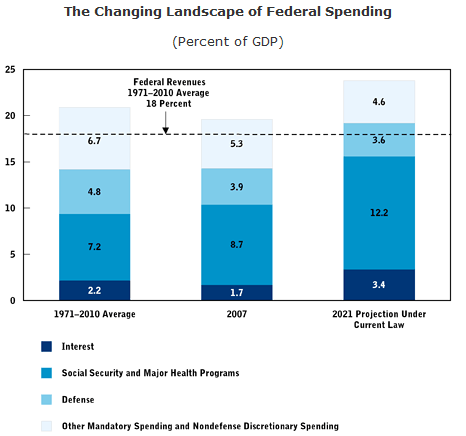CBO has a new report out yesterday that addresses the big questions our nation must face with respect to our long term fiscal situation.The figure below shows that if we maintain our 40 year historical average of 18 percent of GDP raised in taxes, the we will have a deficit simply due to paying for interest, health care, social security and defense in 2021. That means that even with no FBI, FAA, NIH, NEA, Homeland Security, and nothing else but these line items–18% of GDP collected in taxes still won’t be enough to produce a balanced budget. With NO federal spending other than these categories, we will have a deficit in 10 years if our tax code brings in 18% of GDP.
The CBO report is quite clear about our task:
The budget numbers tell a clear story: Given the aging of the population and the rising cost of health care, attaining a sustainable budget for the federal government will require the United States to deviate from the policies of the past 40 years in at least one of the following ways:
- Raise federal revenues significantly above their average share of GDP;
- Make considerable changes to the sorts of federal benefits we provide for older Americans;
- Substantially reduce the role of the rest of the federal government—that is, defense (the largest single piece), Food Stamps, unemployment compensation, other income security programs, veterans’ benefits, federal civilian and military retirement benefits, transportation, health research, education and training, and other programs—in our economy and society.
We as a society will either have to pay more for our government, accept less in government services and benefits, or both. For many people, none of those choices is appealing—but they cannot be avoided for very long.
Our country wants low taxes and high spending. Of course we cannot continue to have that. There is no way we will achieve anything near a balanced budget without a substantial increase in taxes received as a percent of GDP given the difficulty of cutting Medicare and Social Security in the context of the baby boomers moving into eligibility for these programs. Even the 21% of GDP as the target balance point for spending and taxes suggested by the Chairman’s mark of the Fiscal Commission (to be reached in 2035) will be hard to achieve. Spending was higher than 21% of GDP in each year of the Reagan administration (high 23.5% of GDP in 1983; low 21.3% in 1988; table 1.2 in this link). And the baby boomers were working and paying taxes then.
If you want a balanced budget, the ins must match the outs. Under any plausible scenario taxes as a percent of GDP must rise and spending as a percent of GDP must fall. 21% of GDP as a long range target balance point will be hard, but feasible. 18% of GDP seems a fantasy.


